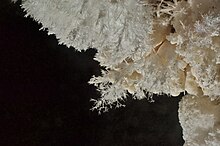This article may lack focus or may be about more than one topic. (November 2024) |


In geology, frostwork is a type of speleothem (cave formation) with acicular ("needle-like") growths almost always composed of aragonite (a polymorph of calcite) or calcite replaced aragonite.[1] It is a variety of anthodite. Frostwork can also be made of opal or gypsum.[2] In some caves frostwork may grow on top of cave popcorn or boxwork.
In architecture frost-work or frostwork refers to a style of rustication carved with a vertically-oriented pattern evoking hanging pond-weed or algae, or icicles. It is mainly found in garden architecture, where water is to flow over or near the surface.[3] Other decorative arts may use the term for other decorative patterns imitating frost or ice.
- ^ Hill, C. and Forti, P. (1997), Cave Minerals of the World, National Speleological Society, 2nd Edition.
- ^ KellerLynn, K. (2009). Wind Cave National Park Geologic Resources Inventory Report (PDF). Denver: National Park Service.
- ^ Looking at buildings, "Rustication"